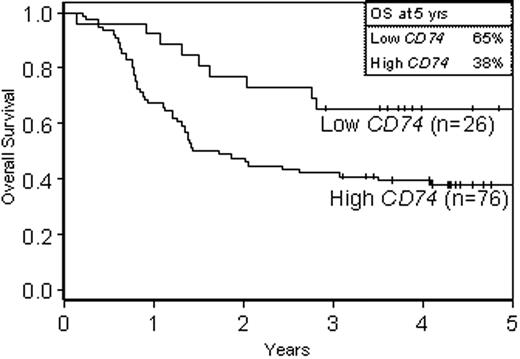Abstract
Abstract 1616
Poster Board I-642
CD74 is a type II integral membrane protein receptor that binds its ligand MIF to induce phosphorylation of the extracellular signal-regulated kinase-1/2 (ERK-1/2) and drive cellular proliferation via nuclear factor-kappa B (NF-kB) activation. CD74 expression has been identified in human solid tumors, and its expression is associated with adverse prognosis in advanced pancreatic cancer. As CD74 is expressed and NF-kB constitutively activated in myeloblasts, we hypothesized that CD74 expression might also be associated with adverse outcome in AML. To investigate the prognostic impact of CD74 expression in the context of other predictive molecular markers in CN-AML, we assessed CD74 expression levels by Affymetrix HG-U133 Plus 2.0 microarray in 102 younger [<60 years (y)] adults with primary CN-AML, treated on the front-line CALGB 19808 trial with an induction regimen containing daunorubicin, cytarabine, etoposide and, in some cases, the inhibitor of multidrug resistance valspodar, and consolidation with autologous stem cell transplantation. Microarray data were analyzed using the Robust Multichip Average method, making use of a GeneAnnot chip definition file, which resulted in a single probe-set measurement for CD74. At diagnosis, CD74 expression, when assessed as a continuous variable, was significantly associated only with extramedullary disease involvement (P=.006) among clinical features, and with none of the molecular prognostic variables tested, including NPM1, WT1, CEBPA, FLT3 (FLT3-ITD and FLT3-TKD) mutations, MLL partial tandem duplication, or differential BAALC and ERG expression levels. Although CD74 expression levels were not associated with achievement of complete remission (CR; 83% vs 81%), higher levels of CD74 were associated with shorter disease-free survival [DFS; P=.046, hazard ratio (HR) 1.85, 95% confidence interval (CI) 1.12-3.08] and with shorter overall survival (OS; P=.02, HR 1.32, CI 1.04-1.67). In multivariable analyses, higher CD74 expression was independently associated with shorter DFS (P=.045, HR 1.98, CI 1.16-3.40), after adjusting for WT1 mutations (P<.001) and FLT3-TKD (P=.04), and shorter OS (P=.01, HR 1.58, CI 1.11-2.25) after adjusting for FLT3-TKD (P=.02), WT1 mutations (P=.007), BAALC expression levels (P=.02), white blood counts (P=.007), and extramedullary involvement (P=.04). As quartiles 2-4 had similar expression levels distinct from the lowest quartile, to display the impact of CD74 expression levels on clinical outcome only, pts were dichotomized into low (the lowest quartile) and high (the top three quartiles) CD74 expressers. The Kaplan-Meier curves for DFS and OS (Figures 1 and 2) are shown below. In conclusion, our study identifies elevated CD74 expression as associated with adverse prognosis in younger CN-AML pts. Since we previously reported that higher CD74 expression was favorably associated with achievement of CR in AML patients receiving chemotherapy plus bortezomib, an inhibitor of the proteasome and NF-kB (Attar et al., Clin Cancer Res, 2008;14:1446-54), it is possible that in future studies elevated CD74 levels can be used not only for prognostication, but also to stratify CN-AML pts to study of bortezomib-containing chemotherapy regimens.
No relevant conflicts of interest to declare.
Author notes
Asterisk with author names denotes non-ASH members.



